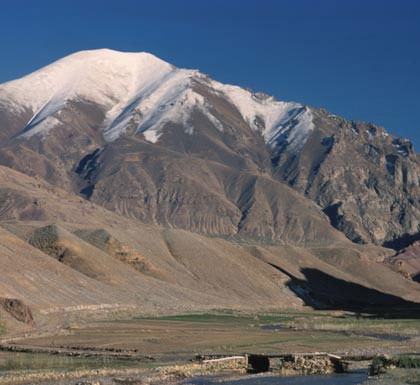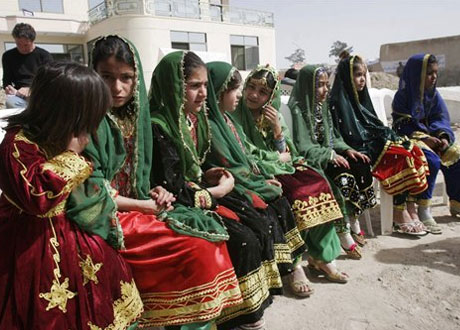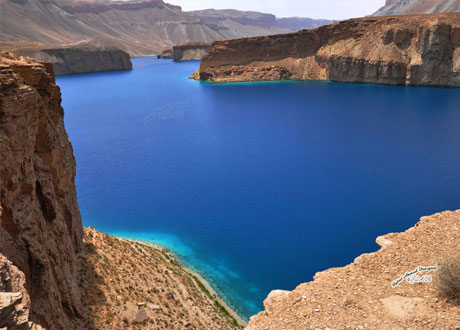Afghanistan
Country statistics

Total area: 250,000 sq miles (647,500 sq km)
Population (2010 est.): 29,121,286 (growth rate: 2.4%); birth rate: 38.11/1000; infant mortality rate: 151.5/1000; life expectancy: 44.6; density per sq miles: 128
Capital City: Kabul
Monetary unit: Afghani
Languages: Dari Persian, Pashtu (both official), other Turkic and minor languages
Ethnicity/race: Pashtun 42%, Tajik 27%, Hazara 9%, Uzbek 9%, Aimak 4%, Turkmen 3%, Baloch 2%, other 4%
Religions: Sunni Muslim 80%, Shi'a Muslim 19%, other 1%
Country introduction

Afghanistan is a landlocked country located in South Asia. It is bordered on the north by Turkmenistan, Uzbekistan, and Tajikistan, on the extreme northeast by China, on the east and south by Pakistan, and by Iran on the west.
There is wide variation in Afghanistan's geography, including the fertile mountain valleys in the east, plains and grasslands in the north, a central mountain core, and deserts and semi-deserts in the west and south-west.
The dominant geographic feature of the country is the huge mountain range known as the Hindu Kush, which split east to west, rising in the east to heights of 7,315 m (24,000 ft). To the west of the Hindu Kush, the land gradually slopes downward into sparsely habitated, arid to semi-arid rocky deserts. The lowest elevation is 258 m (846 ft) along the northern border with Uzbekistan and Turkmenistan on the Amu Darya or Oxus River.
The Hindu Kush mountain divides Afghanistan into three major regions; the Central Highlands, which forms part of the Himalayas and account for roughly two thirds of the country's area; the South-western Plateau, which accounts for one-fourth of the land; and the smaller Northern Plains area, which contains the country's most fertile soil. The highest point is Mount Nowshak, at 7,485 m (24,557 ft) above sea level.
The country frequently experiences minor earthquakes, mainly in the mountainous areas northeast of the Hindu Kush mountain range. Approximately 125 villages were damaged and 4,000 people killed by an earthquake on May 30, 1998.
One of the main rivers of the country is the Amu Darya or Oxus River at a length of 2,400 km (1,491 miles). It flows out of the Karakorum Range and the Pamir Knot to form much of the northern border of the country. The others rise in the Hindu Kush Mountains, such as the Konar River in the east, the Alingar and Alisheng Rivers in Laghman Province, and the Panjshir and Kabul Rivers.
The culture

The culture of Afghanistan has been influenced by many aspects. For centuries Afghanistan had been used by invaders as their gateway to India and other central Asian countries. Afghanistan has been the part of several mighty and culturally rich empires, which left their legacy in the region. The Culture of Afghanistan is therfore the result of rich and long cultural heritage left in Afghanistan by Greeks, Persians and Indians.
Islam had its impact on Afghanistan culture. Islamic threads were left in the art, music, architecture and poetry of Afghanistan. Due to constant battles and wars the cultural assets of Afghanistan have blemished in recent times. Afghans are expert in embellishing their daily life articles with fine arts and calligraphy.
The Afghan culture is replete with a number of festivals. As an Islamic country, the festivals in Afghanistan are of Muslim origin. Eid al Fitr (end of Ramadan) is the most important festival of Afghanistan. The whole month of Ramadan is considered as the month of sacrifice and purity. Muharram commemorates the martyrdom of Hazrat Imam Hussain. Eid al-Adha (Eid-e-Qurban) is also one of the holy days of Afghans. New year day is celebrated as Nau Roz on the first day of spring according to Afghan solar calendar. Mawlud-un Nabi and Lailat-ul Qadr are also common festivals of Afghanistan.
Buzkashi is a significant part of the Afghan culture. It is one of the ancient games played in Afghanistan. Buzkashi literally means "goat killing" and the name was derived from hunting of mountain goats by champions on horseback. The game originated from the time of Ghengis Khan, one of the rulers of medieval Afghanistan. Provinces of Maimana, Mazar-i-Sharif, and Kataghan are the most popular destinations for Buzkashi. Due to the religious belief women are not allowed to watch the game. There are mainly two types of Buzkashi played, Tudabarai & Qarajai.
Both male and female Afghans have to wear tradition clothing. The traditional clothes that male Afghans have to wear are a Packol (hat), Lungee (turban), and a Chapan (coat). Most traditional women of Afghanistan wear a long dress with round skirt slightly similar to a "salwar kameez". Some females wear a chador, which is a piece of clothing that covers the head, shoulders, and face, but not the eyes. Often, the dress of Afghanis combines several colors often representing the color of the flag. If the weather is cold, both males and females can wear sweaters, jackets, and coats.
Afghan cuisine is enriched with spices and rich aroma. Afghanistani cuisine is mainly influenced by that of Persia, India and Mongolia. Main ingredients are spices from India; mint, meat cookery, subzi from Persia and the noodles/ pasta from Mongolia. Afghani cuisine is flavored with garam masala, saffron, cinnamon, cloves, cardamom, chilis, leeks, coriander, parsley, mint and black pepper. Pulao and Qabli puloao are famous dishes from Afghanistan. Vegetarian dishes are not so popular in Afghanistan culture. Due to environmental factors people take food rich in fat and protein.
Attractions & landmarks

Despite suffering almost 30 years of warfare and authoritarian regimes, Afghanistan is still a beautiful mountainous country, boasting some truly breathtaking tourist attractions.
One such breathtaking attraction is the Band-e Amir lake, which consists of six deep blue lakes nestled amidst the limestone canyons. The lakes are situated in the Hindu Kush mountains, west of the famous Buddhas of Bamiyan, which are two 6th century monumental statues of standing buddhas carved into the side of a cliff in the Bamiyan valley. Band-e Amir is also referred to as the Lake of Jewels due to its undisturbed pure-blue, turquoise coloured water. Fishing for carp, known locally as milk fish, is a common sight along the lake shores.
Bamiyan Valley, a 3 hour drive from the lakes, offers numerous day hikes to explore the historical and cultural attractions. The Koh-e-Baba mountains rising to nearly 5000 m (16,404 ft) south of the main valley are little known to anyone but the local shepherds and will offer visitors a considerable scope for exploration. There is great potential for horseriding, whether exploring the villages or venturing on longer horse trips with a local guide. One route which can be completed in two days is a trail between Bamiyan town and Band-e-Amir. Another from Band-e-Amir to the Ajar valley can be hiked on foot or by horse in two to three days. The valley also contains numerous archaeological remains of Buddhist monastic ensembles and sanctuaries, as well as fortified edifices from the Islamic period. A good example of a historical ruin site can be found in the Shahr-i-Zohak fortress, which overlooks the red sandstone mountain side, above a 30 m (100 ft) cliff, situated about 10 km (6 miles) south of Bamiyan City.
Another natural landmark is the Tora Bora, which can literally be translated as Black Dust. It is a cave complex in eastern Afghanistan. The complex hosts itself in the White Mountains locally known as Safed Koh. Tora Bora is approximately 50 km (31 miles) west of the Khyber Pass. The US forces battled with Al Qaeda and the Taliban in Tora Bora, during the US invasion of Afghanistan in 2001.
Khyber Pass has been an important site in Afghanistan. This 53 km (33 miles) mountain pass has allowed a link between Pakistan and Afghanistan. Throughout history it served an important trade route between Central Asia and South Asia. Great camel caravans traveled through the Khyber Pass, bringing goods to trade. These ancient merchants and traders brought luxurious silks and fine porcelain objects from China to the Middle East. Often, they stopped at Herat, the great oasis in western Afghanistan. The Khyber Pass has also seen countless invasions, from the Persian, Greek, Tatar, Mogul, and Afghan invasions of India.
Panjshir valley is another most visited tourist destinations due astonishing natural beauty. It is located 150 km (93 miles) north of Kabul, near the Hindu Kush mountain. It is desirable to go mountain climbing during summer and skiing in winter. It is also a great place to go for a picnic and since the river flows through almost every village in Panjshir, swimming and fishing is very popular.